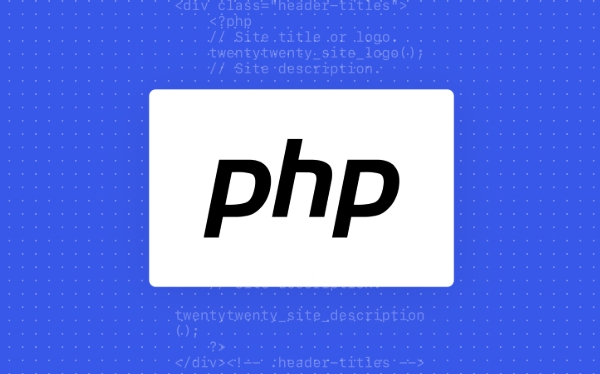PHP is a server-side scripting language used for web development, especially for dynamic websites and CMS platforms like WordPress. It runs on the server, processes data, interacts with databases, and sends HTML to browsers. Common uses include user authentication, e-commerce platforms, form handling, and powering sites like Facebook and Wikipedia. Compared to other languages, PHP has an easy learning curve, strong CMS support, and widespread hosting availability.

PHP is a server-side scripting language designed for web development, though it can also be used for other types of applications. It’s especially popular for building dynamic websites and powering content management systems like WordPress.

What Exactly Is PHP?
PHP stands for Hypertext Preprocessor. Originally created in 1994, it's evolved into one of the most widely-used languages for web backends. Unlike front-end languages like JavaScript (which run in the browser), PHP runs on the server — meaning it processes data, interacts with databases, and sends HTML to the browser.
Here’s how it typically works:

- A user visits a webpage.
- The server runs the PHP code.
- The result is turned into HTML and sent to the browser.
It’s often embedded directly into HTML files, which makes it easy to mix static content with dynamic logic.
Why Use PHP? Common Use Cases
PHP shines when you need to build dynamic websites or apps that interact with databases. Here are some typical uses:

- ? Content Management Systems (CMS): WordPress, Drupal, and Joomla are all built with PHP. They let users create blogs, stores, or business sites without needing deep coding skills.
- ? User Authentication: Logging in, managing profiles, storing preferences — PHP handles the backend logic easily.
- ? E-commerce Platforms: WooCommerce, Magento, and OpenCart rely on PHP to manage products, payments, and shopping carts.
- ? Form Handling: When you submit a contact form, PHP can process that data, validate it, and store it in a database or send emails.
You’ll see PHP being used wherever there’s a need to generate personalized content on the fly — like showing different content based on user login status or location.
Who Uses PHP Today?
Despite newer languages and frameworks popping up, PHP is still alive and well. Some of the biggest websites in the world use PHP or a framework built with it:
- Facebook originally started with PHP and still uses a version of it (HHVM) internally.
- Wikipedia runs on MediaWiki, which is written in PHP.
- WordPress.com, the hosted version of WordPress, powers over 40% of all websites — and it’s all in PHP.
Many small businesses, freelancers, and agencies continue to use PHP because it’s mature, has lots of documentation, and integrates smoothly with MySQL (a common database system).
How Does PHP Compare to Other Languages?
PHP isn’t always the first choice for new developers these days, but it holds its own depending on what you're trying to do.
| Feature | PHP | JavaScript (Node.js) | Python (Django/Flask) |
|---|---|---|---|
| Learning Curve | Easy for beginners | Moderate | Moderate |
| Speed | Fast enough | Very fast | Slightly slower |
| Ecosystem | Strong CMS support | Huge frontend/backend | Great for AI/data |
| Hosting Availability | Built-in support | Requires setup | Varies |
If you're building a blog or an online store quickly, PHP might be your best bet. But if you’re doing machine learning or real-time apps, you’d probably lean toward Python or JavaScript.
That’s the core of what PHP is and why people still use it. It may not be trendy, but it gets the job done — especially when you want something functional without reinventing the wheel.
The above is the detailed content of What is PHP and What is it Used For?. For more information, please follow other related articles on the PHP Chinese website!

Hot AI Tools

Undress AI Tool
Undress images for free

Undresser.AI Undress
AI-powered app for creating realistic nude photos

AI Clothes Remover
Online AI tool for removing clothes from photos.

Clothoff.io
AI clothes remover

Video Face Swap
Swap faces in any video effortlessly with our completely free AI face swap tool!

Hot Article

Hot Tools

Notepad++7.3.1
Easy-to-use and free code editor

SublimeText3 Chinese version
Chinese version, very easy to use

Zend Studio 13.0.1
Powerful PHP integrated development environment

Dreamweaver CS6
Visual web development tools

SublimeText3 Mac version
God-level code editing software (SublimeText3)
 PHP calls AI intelligent voice assistant PHP voice interaction system construction
Jul 25, 2025 pm 08:45 PM
PHP calls AI intelligent voice assistant PHP voice interaction system construction
Jul 25, 2025 pm 08:45 PM
User voice input is captured and sent to the PHP backend through the MediaRecorder API of the front-end JavaScript; 2. PHP saves the audio as a temporary file and calls STTAPI (such as Google or Baidu voice recognition) to convert it into text; 3. PHP sends the text to an AI service (such as OpenAIGPT) to obtain intelligent reply; 4. PHP then calls TTSAPI (such as Baidu or Google voice synthesis) to convert the reply to a voice file; 5. PHP streams the voice file back to the front-end to play, completing interaction. The entire process is dominated by PHP to ensure seamless connection between all links.
 How to use PHP to build social sharing functions PHP sharing interface integration practice
Jul 25, 2025 pm 08:51 PM
How to use PHP to build social sharing functions PHP sharing interface integration practice
Jul 25, 2025 pm 08:51 PM
The core method of building social sharing functions in PHP is to dynamically generate sharing links that meet the requirements of each platform. 1. First get the current page or specified URL and article information; 2. Use urlencode to encode the parameters; 3. Splice and generate sharing links according to the protocols of each platform; 4. Display links on the front end for users to click and share; 5. Dynamically generate OG tags on the page to optimize sharing content display; 6. Be sure to escape user input to prevent XSS attacks. This method does not require complex authentication, has low maintenance costs, and is suitable for most content sharing needs.
 How to use PHP combined with AI to achieve text error correction PHP syntax detection and optimization
Jul 25, 2025 pm 08:57 PM
How to use PHP combined with AI to achieve text error correction PHP syntax detection and optimization
Jul 25, 2025 pm 08:57 PM
To realize text error correction and syntax optimization with AI, you need to follow the following steps: 1. Select a suitable AI model or API, such as Baidu, Tencent API or open source NLP library; 2. Call the API through PHP's curl or Guzzle and process the return results; 3. Display error correction information in the application and allow users to choose whether to adopt it; 4. Use php-l and PHP_CodeSniffer for syntax detection and code optimization; 5. Continuously collect feedback and update the model or rules to improve the effect. When choosing AIAPI, focus on evaluating accuracy, response speed, price and support for PHP. Code optimization should follow PSR specifications, use cache reasonably, avoid circular queries, review code regularly, and use X
 PHP creates a blog comment system to monetize PHP comment review and anti-brush strategy
Jul 25, 2025 pm 08:27 PM
PHP creates a blog comment system to monetize PHP comment review and anti-brush strategy
Jul 25, 2025 pm 08:27 PM
1. Maximizing the commercial value of the comment system requires combining native advertising precise delivery, user paid value-added services (such as uploading pictures, top-up comments), influence incentive mechanism based on comment quality, and compliance anonymous data insight monetization; 2. The audit strategy should adopt a combination of pre-audit dynamic keyword filtering and user reporting mechanisms, supplemented by comment quality rating to achieve content hierarchical exposure; 3. Anti-brushing requires the construction of multi-layer defense: reCAPTCHAv3 sensorless verification, Honeypot honeypot field recognition robot, IP and timestamp frequency limit prevents watering, and content pattern recognition marks suspicious comments, and continuously iterate to deal with attacks.
 How to use PHP to combine AI to generate image. PHP automatically generates art works
Jul 25, 2025 pm 07:21 PM
How to use PHP to combine AI to generate image. PHP automatically generates art works
Jul 25, 2025 pm 07:21 PM
PHP does not directly perform AI image processing, but integrates through APIs, because it is good at web development rather than computing-intensive tasks. API integration can achieve professional division of labor, reduce costs, and improve efficiency; 2. Integrating key technologies include using Guzzle or cURL to send HTTP requests, JSON data encoding and decoding, API key security authentication, asynchronous queue processing time-consuming tasks, robust error handling and retry mechanism, image storage and display; 3. Common challenges include API cost out of control, uncontrollable generation results, poor user experience, security risks and difficult data management. The response strategies are setting user quotas and caches, providing propt guidance and multi-picture selection, asynchronous notifications and progress prompts, key environment variable storage and content audit, and cloud storage.
 PHP realizes commodity inventory management and monetization PHP inventory synchronization and alarm mechanism
Jul 25, 2025 pm 08:30 PM
PHP realizes commodity inventory management and monetization PHP inventory synchronization and alarm mechanism
Jul 25, 2025 pm 08:30 PM
PHP ensures inventory deduction atomicity through database transactions and FORUPDATE row locks to prevent high concurrent overselling; 2. Multi-platform inventory consistency depends on centralized management and event-driven synchronization, combining API/Webhook notifications and message queues to ensure reliable data transmission; 3. The alarm mechanism should set low inventory, zero/negative inventory, unsalable sales, replenishment cycles and abnormal fluctuations strategies in different scenarios, and select DingTalk, SMS or Email Responsible Persons according to the urgency, and the alarm information must be complete and clear to achieve business adaptation and rapid response.
 Beyond the LAMP Stack: PHP's Role in Modern Enterprise Architecture
Jul 27, 2025 am 04:31 AM
Beyond the LAMP Stack: PHP's Role in Modern Enterprise Architecture
Jul 27, 2025 am 04:31 AM
PHPisstillrelevantinmodernenterpriseenvironments.1.ModernPHP(7.xand8.x)offersperformancegains,stricttyping,JITcompilation,andmodernsyntax,makingitsuitableforlarge-scaleapplications.2.PHPintegrateseffectivelyinhybridarchitectures,servingasanAPIgateway
 PHP integrated AI speech recognition and translator PHP meeting record automatic generation solution
Jul 25, 2025 pm 07:06 PM
PHP integrated AI speech recognition and translator PHP meeting record automatic generation solution
Jul 25, 2025 pm 07:06 PM
Select the appropriate AI voice recognition service and integrate PHPSDK; 2. Use PHP to call ffmpeg to convert recordings into API-required formats (such as wav); 3. Upload files to cloud storage and call API asynchronous recognition; 4. Analyze JSON results and organize text using NLP technology; 5. Generate Word or Markdown documents to complete the automation of meeting records. The entire process needs to ensure data encryption, access control and compliance to ensure privacy and security.






